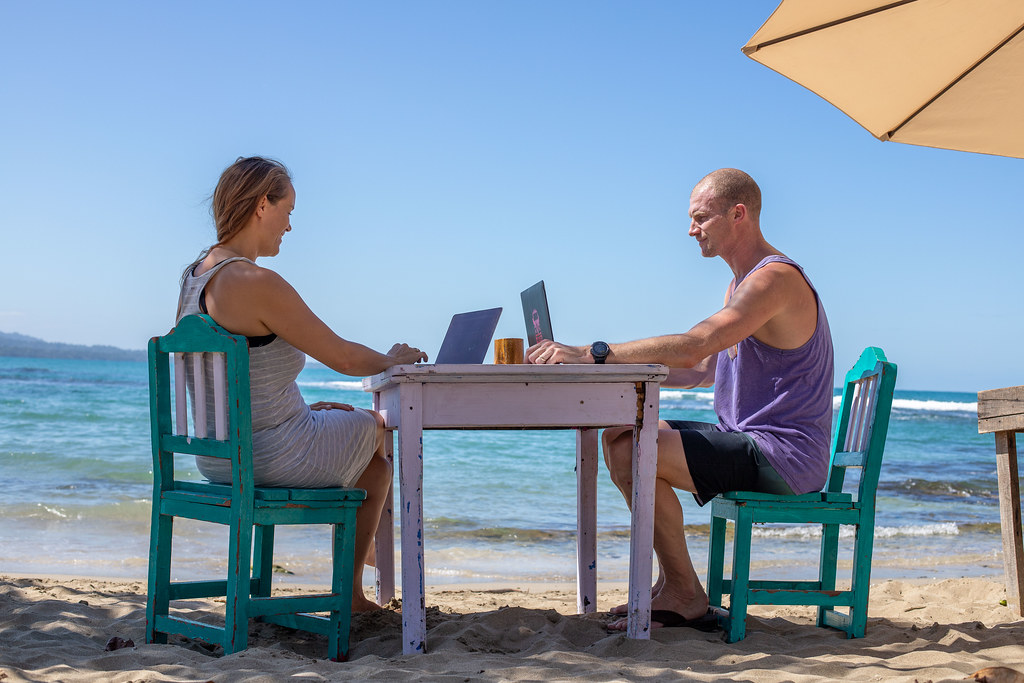How to Transition to a Digital Nomad Lifestyle from a 9-5 Job

Imagine the sun setting over a Balinese rice terrace as you finish up a day’s work from your laptop, or sipping a latte in a quaint Parisian cafe as you join a video conference. Sounds like a dream? Well, it’s a reality for digital nomads who’ve traded the 9-5 grind for a life of freedom and adventure. If you’re yearning to explore the world while maintaining a career, you’re in the right place.
Key Takeaways
- Understand what a digital nomad lifestyle entails and its benefits.
- Learn the steps to transition from a traditional job to a digital nomad.
- Discover essential tools and technology for successful remote work.
- Get practical advice on planning your travels and managing finances.
- Join a community of like-minded individuals for support and networking.
Embrace the Freedom: Transitioning to a Digital Nomad Lifestyle
Defining the Digital Nomad Lifestyle
At its core, being a digital nomad means having the freedom to work from anywhere in the world, as long as you have an internet connection. This lifestyle is about blending work and travel, not just taking a permanent vacation. It requires discipline, planning, and a passion for both your job and exploring new cultures.
Perks of Going Nomad
Why do people choose this lifestyle? The perks are many: from personal growth and flexibility to the opportunity to live in a way that aligns with your values and interests. Most importantly, you get to be the architect of your own life, designing each day to bring you joy and fulfillment.

“Digital Nomads Puerto Viejo | Steven …” from www.flickr.com
Chart Your Course: Pre-Transition Strategy
Finding Your Remote Fit: Skills and Passions
The first step in your journey is to assess your current skills and passions. Can your job be done remotely? If not, what skills can you develop that would enable you to work online? There are numerous paths to choose from, whether it’s freelance writing, web development, or virtual assistance, to name a few.
For example, Sarah was a marketing manager with a passion for graphic design. She honed her design skills, built a portfolio, and transitioned to freelance work, allowing her to travel and work simultaneously.
Once you’ve identified a remote-friendly career path, it’s time to gain the necessary skills. There are countless online courses and resources available to help you upskill or reskill. And remember, the most sought-after digital nomad skills are often those that are also in high demand globally.
Money Matters: Building Your Financial Runway
Before taking off, you need a financial plan. This includes saving money to cover your initial costs, like flights and accommodations, and ensuring you have a steady income stream once you start traveling. Budgeting becomes your best friend, and so does a solid emergency fund.
Here’s a rough breakdown of initial costs:
- Flight to your first destination: $300-$800
- First month’s accommodation: $500-$1500
- Co-working space membership: $50-$200/month
- Travel insurance: $100-$300/month
Besides that, consider ongoing expenses such as food, transportation, and activities. Creating a budget spreadsheet can help you keep track of your expenses and manage your finances effectively.
Cultivating Connections:

“When You’re a ‘Digital Nomad,’ the …” from www.nytimes.com
Building a network is crucial for finding work, staying connected, and maintaining a support system while on the road. Join online communities, attend webinars, and connect with fellow nomads on social media platforms. One such vibrant community dedicated to digital marketing and entrepreneurial growth is GNTSocial.com. Here, you can expand your network, exchange ideas, and find resources for your business ventures.
Transitioning to a digital nomad lifestyle isn’t just about finding the right job; it’s also about having the right tools. You’re going to need software that’s as flexible and reliable as you aim to be. Think about project management tools like Trello or Asana, communication platforms like Slack, and cloud storage services like Google Drive or Dropbox. These will become your virtual office, keeping you organized and connected, no matter where in the world you’re working from.
Remote Work Applications: Software That Works as Hard as You Do
When you’re traversing continents, your software suite needs to be as nomadic as you are. Here are some must-haves:
- Communication tools like Zoom and Skype for video calls and meetings.
- Time-tracking software like Toggle or Harvest to stay on top of your hours.
- Cloud-based document and spreadsheet editors like Google Workspace for collaboration.
- Password managers like LastPass to securely manage your online accounts.
- VPN services to ensure your internet connection is secure and to access geo-restricted content.
Mapping Your Journeys: Practicalities of Nomadic Living
As you gear up for the nomadic life, mapping out your journey is essential. It’s not just about picking destinations that appeal to you; it’s also about understanding the practicalities that come with each location. You’ll need to consider the cost of living, the availability of co-working spaces, the local culture, and the community of digital nomads already there.
And it’s not just about the big picture. It’s the little things too – like knowing the best local cafes with Wi-Fi or where to find a quiet spot for a conference call. These nuances make all the difference in your day-to-day nomadic life.
Take, for example, nomad hotspots like Chiang Mai or Medellin. These cities are not only affordable but also brimming with a community of like-minded individuals, making the transition smoother and more enjoyable.
Choosing Your Destinations: Factors to Consider
Choosing the right destinations to kick off your digital nomad journey can be thrilling. But keep in mind, each place comes with its own set of pros and cons. Here’s what you should consider:
- Cost of living: Can you afford to live comfortably while saving money?
- Internet reliability: Is the Wi-Fi fast and stable for your work needs?
- Community: Is there a network of other digital nomads or expats?
- Visa requirements: How easy is it to stay long-term?
- Time zone: Will it align with your clients’ or employer’s schedule?

“Free Accommodation While Traveling …” from whereintheworldisnina.com
Finding the right place to stay is more than just booking a hotel room. As a digital nomad, you’ll need something that feels like home and suits your work style. Consider options like Airbnb for short-term stays, or even co-living spaces that cater specifically to digital nomads, offering both accommodation and working areas.
Remember, the goal is to find a balance between comfort, cost, and convenience. And don’t be afraid to negotiate; many places offer discounts for longer stays.
Here are some quick tips for finding the perfect nomad accommodation:
- Read reviews from other digital nomads on platforms like Nomad List.
- Look for places with dedicated workspaces or proximity to co-working spaces.
- Check the Wi-Fi speed – many listings now include this information.
Planning for Movement: Transportation Tips
Getting from A to B is an inevitable part of the nomadic lifestyle. Whether it’s international flights, local buses, or ride-sharing, planning your transportation in advance can save you both time and stress. Be aware of common rental scams to avoid pitfalls in your nomadic journey.
Most importantly, always have a backup plan. Flights get delayed, buses miss stops, and sometimes, you just want to stay a little longer. Flexibility is your best asset.
Challenges on the Road: Navigating the Bumps
It’s not all smooth sailing. There will be challenges – like finding a strong enough Wi-Fi signal to meet a deadline, or dealing with the loneliness that can come from being far from family and friends. But these bumps on the road are part of the journey and overcoming them is part of what makes you a seasoned digital nomad.
Here’s how you can prepare for and overcome some common roadblocks:
- Always have a local SIM card with enough data as a backup for Wi-Fi.
- Join local meetups or online communities to combat loneliness.
- Set a regular schedule to stay in touch with loved ones back home.
Overcoming Isolation as a Nomad
While the freedom of solo travel is exhilarating, it can also lead to feelings of isolation. That’s why it’s vital to build a network, even on the move. Online communities of digital nomads can be a great resource for both professional growth and personal support.
Platforms like GNTSocial.com offer a space to connect with fellow nomads, share experiences, and even collaborate on projects. It’s a way to keep grounded and maintain a sense of belonging, no matter where your travels take you.
Dealing with Unreliable Wi-Fi and Tech Troubles
As a digital nomad, your work depends on reliable internet. But let’s face it, Wi-Fi won’t always be on your side. Therefore, it’s crucial to have contingency plans. Carry a portable Wi-Fi device or research local cafes with reliable connections before you arrive. Remember, a tech hiccup shouldn’t derail your entire day.
Moreover, keep your tech gear in check. Regularly update your software, back up your data, and invest in sturdy cases for your devices. When you’re on the move, your laptop is your lifeline. Treat it with care!
Finding a Balance: Work and Wander
One of the biggest challenges you’ll face is finding the right balance between work and exploration. It’s tempting to see everything, but remember, you’re not on vacation. To sustain this lifestyle, you need to prioritize your work. Establish a routine, set clear work hours, and stick to them. That way, you can enjoy your surroundings without the guilt or stress of unfinished tasks. For more tips on managing your workload on the go, check out this remote work starter kit for digital nomads.
Lift-Off: Your Digital Nomad Launch Plan
Final Preparations: Before You Go Checklist
Before you board that plane, make sure you’ve checked these off your list:
- Notify your bank to prevent any surprise fraud alerts.
- Set up mail forwarding or a virtual mailbox service.
- Ensure all travel documents are up to date and accessible.
- Secure travel and health insurance that covers international care.
- Have a clear plan for your first few weeks, including workspaces.
These steps are not just administrative; they’re your safety net. By taking care of these details, you’re setting yourself up for a smoother transition. Trust me, the peace of mind you’ll have knowing these are sorted is invaluable.
Remember to also have an exit strategy. If things don’t work out, or you decide the nomad life isn’t for you, it’s okay. Having a plan to return or move onto another adventure is just as important as the leap itself.
Setting Sail: Starting Your Nomad Journey
Now, the moment you’ve been waiting for: it’s time to start your nomad journey. Begin with a soft launch. Choose a destination that’s not too far from home, or one that has a strong nomad community. This will allow you to ease into the lifestyle and work out any kinks before venturing further afield.
Most importantly, embrace the journey. You’ll learn and grow in ways you never imagined. The digital nomad lifestyle is as much about the internal voyage as it is about the external adventures. Go forth with an open heart and a curious mind.
FAQ
Got more questions? Here are some answers to common queries:
What Skills Are Best for Digital Nomads?
Skills that are in high demand and can be done remotely are ideal for digital nomads. This includes web development, graphic design, content writing, digital marketing, and online teaching. The key is to have a skill set that allows you to work independently and provide value to clients or employers from anywhere in the world.
How Much Savings Do I Need Before I Transition?
You should have enough savings to cover at least 3-6 months of living expenses. This gives you a buffer to find consistent work and deal with any unexpected costs. Depending on your destination, this could range from $5,000 to $15,000. For more detailed guidance, check out our ultimate guide to budgeting & investing for digital nomads.
How Do I Choose the Right Technology for Remote Work?
Opt for lightweight, durable, and high-performance technology. A reliable laptop, noise-cancelling headphones, and a smartphone with a good camera are essentials. Research gadgets that are popular among digital nomads for their reliability and longevity.
What Are the Best Ways to Stay Connected Internationally?
Invest in a global SIM card or a local SIM upon arrival for data. Use communication apps like WhatsApp, Telegram, or Signal to stay in touch with clients and family. And don’t forget to leverage co-working spaces for their high-speed internet and networking opportunities.
How Do I Handle Healthcare as a Digital Nomad?
Secure an international health insurance plan that provides comprehensive coverage worldwide. Always carry a basic first-aid kit, and familiarize yourself with the healthcare system of the countries you’re visiting. Additionally, maintain a healthy lifestyle to prevent illness and ensure you can fully enjoy your travels.






[…] the tech hubs to the beachfront paradises, the USA is brimming with cities that cater to the digital nomad lifestyle. But which ones truly stand out? Let’s dive into what makes a city a top pick for nomads like […]